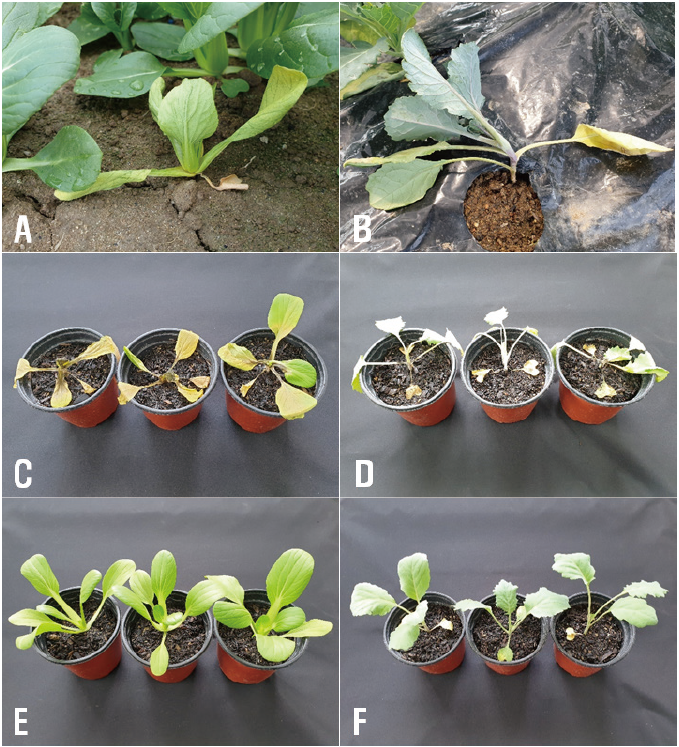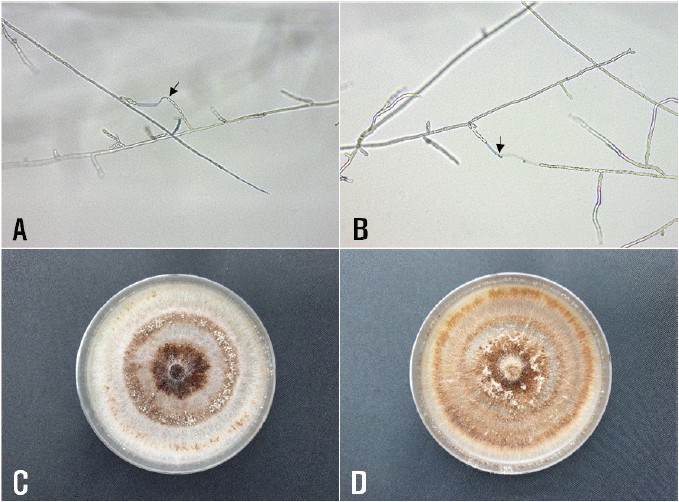Bok choy [Brassica rapa L. subsp. chinensis (L.) Hanelt] and kale (Brassica oleracea L. var. viridis L.) are widely cultivated worldwide as important vegetables. The vegetables are mainly grown in vinyl greenhouses by farmers in Korea. Foot rot symptoms were occasionally observed on young bok choy and kale plants grown in vinyl greenhouses located in Icheon and Yangpyeong, Gyeonggi Province, Korea, during disease surveys in April 2020. The diseased plants had retarded growth and the disease symptoms initially manifested on the plant stems or roots at the soil line. The infected plant tissues receded and were thin, discolored, and rotten. Diseased plants withered, blighted, and subsequently collapsed (Fig. 1A and 1B). Three sites were chosen for observation in the vinyl greenhouse and 100 plants at each site were investigated for incidence of the disease. The incidence of diseased plants in the vinyl greenhouses investigated was 0.5-1.0% in bok choy and 0.5-5.0% in kale (Table 1).
Rhizoctonia sp. was consistently isolated from the diseased plants of bok choy and kale. Five isolates of Rhizoctonia sp. were obtained from diseased roots of bok choy and three isolates of Rhizoctonia sp. were taken from diseased stems of kale. All the isolates were identified as Rhizoctonia solani Kühn based on the morphological characteristics as per descriptions from previous studies [1,2].

Fig. 1. Foot rot symptoms in bok choy and kale. A and B, symptoms on young plants of bok choy and kale, respectively observed in the vinyl greenhouses investigated; C and D, symptoms on plants of bok choy and kale, respectively induced by artificial inoculation tests with Rhizoctonia solani AG-2-1 isolates; E and F, non-inoculated plants of bok choy and kale (control), respectively.
The isolates were evaluated to classify anastomosis groups using tester isolates of R. solani as previously described [3]. The R. solani tester isolates AG-1 (KACC 40101), AG-2-1 (KACC 40119), AG-2-2 (40125), AG-3 (KACC 40138), AG-4 (KACC 40139), and AG-5 (KACC 40146) were obtained from the Agricultural Microbiology Division of the National Institute of Agricultural Sciences in Korea. All the tested isolates were classified as R. solani AG-2-1. Anastomosis reactions between the tested isolates and the tester isolates of R. solani AG-2-1 are shown in Fig. 2A and 2B. Mycelia of the isolates cultured on potato dextrose agar (PDA) were brown to reddish brown, and the colonies showed clear concentric zones (Fig. 2C and 2D). Sclerotia were mostly formed in the concentric zones on the medium.

Fig. 2. Anastomosis tests of Rhizoctonia solani isolates from bok choy and kale, and cultural appearance of the isolates. A and B, anastomosis reactions between the tested isolate (left) and the tester isolate (right) of R. solani AG-2-1 from bok choy and kale, respectively observed by light microscope; C and D, colonies of R. solani AG-2-1 isolates from bok choy and kale, respectively grown on potato dextrose agar at 24℃ for eight days.
Three isolates of R. solani AG-2-1 from both bok choy and kale were tested for pathogenicity in their host plants by artificial inoculation. Mycelial disks 6 mm in diameter were cut from the margins of actively growing cultures of each isolate on PDA, and placed at the soil surface level of 21-day-old bok choy and kale plants. These plants were grown in circular plastic pots (height, 9 cm; upper diameter, 10 cm; lower diameter, 7 cm) in the vinyl greenhouse. Inoculated potted plants were placed in plastic boxes (60 cm×43 cm×33 cm) with 100% relative humidity at room temperature (24-26℃) for two days. Thereafter, the inoculated potted plants were removed from the boxes and kept indoors. The virulence of the isolates was rated based on the degree of foot rot symptoms five days after inoculation. The inoculation test was performed in three replicates.
The tested isolates of R. solani AG-2-1 induced foot rot symptoms on the inoculated plants of bok choy and kale (Fig. 1C and 1D), whereas no symptoms were observed on the control plants (Fig. 1E and 1F). The symptoms on the plants of bok choy and kale, induced by the artificial inoculation, were similar to those observed on plants from the vinyl greenhouses investigated. The isolates which induced symptoms on the plants were re-isolated from the lesions.
R. solani is reported to cause damping-off, root and stem rot, bottom rot, leaf blight, etc., in many crops [4-6]. It has also been reported that in bok choy, R. solani AG-1ⅠB and R. solani AG-2-1 can cause foliar rot [7] and bottom rot [8], respectively. The present study revealed that R. solani AG-2-1 causes foot rot in bok choy. Foot rot was found to be different from bottom rot in terms of the symptom formation on bok choy plants. Foot rot showed root rot symptoms on young plants, while bottom rot showed petiole rot symptoms in the mid- and late-growth stages of plants [8]. Differences in the symptoms of the diseases caused by the same pathogen are thought to be related to the growth stage of the plant; however, further study will be needed to clarify the differences in the symptoms of these diseases.
Damping-off in kale is reported to be caused by R. solani AG-4 [9] and the present study revealed that R. solani AG-2-1 also causes foot rot on young kale plants. However, it is considered that R. solani AG-2-1 could also cause damping-off in the earlier growth stages of the plant. There has been no prior report on diseases of bok choy and kale caused by R. solani AG-2-1 in Korea. This is the first report of R. solani AG-2-1 causing foot rot in bok choy and kale in Korea.



